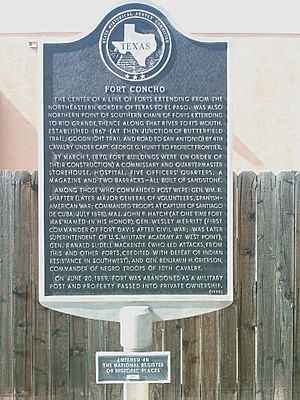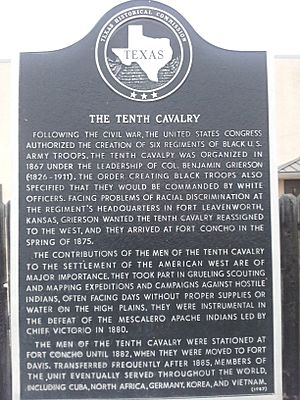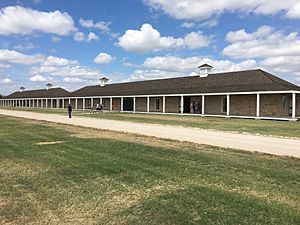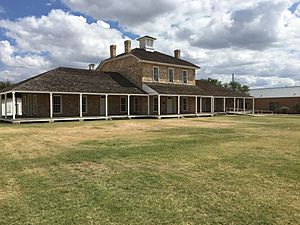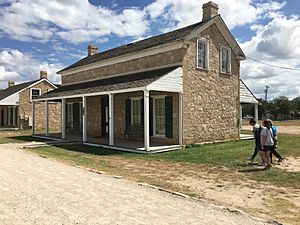Fort Concho facts for kids
|
Fort Concho Historic District
|
|
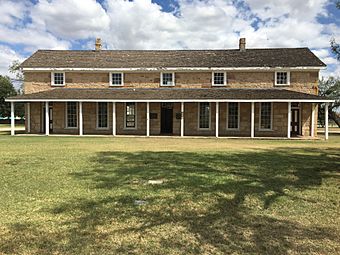
Headquarters building, September 2017
|
|
| Location | San Angelo, Texas, United States |
|---|---|
| NRHP reference No. | 66000823 |
Quick facts for kids Significant dates |
|
| Added to NRHP | October 15, 1966 |
| Designated NHLD | July 4, 1961 |
Fort Concho is an old United States Army base located in San Angelo, Texas. It was built in November 1867 where the North and South Concho Rivers meet. The fort was an active military base for 22 years.
Soldiers at Fort Concho helped protect important routes like the Butterfield Overland Mail Route and the Goodnight–Loving Trail. It was home to the 4th Cavalry from 1867 to 1875. After that, the famous "Buffalo Soldiers" of the 10th Cavalry were stationed there from 1875 to 1882. These soldiers took part in important campaigns like the Red River War in 1874.
The fort was closed in June 1889. Over time, its buildings were used for homes and businesses. People started working to save and restore Fort Concho in the 1900s. This led to the Fort Concho Museum opening in 1929. The city of San Angelo has owned and managed the fort since 1935.
Fort Concho was named a National Historic Landmark on July 4, 1961. It is one of the best-preserved examples of military bases built by the US Army in Texas. The Fort Concho Historic District covers the fort's original 40 acres and includes 23 buildings. Some of these are the oldest buildings in San Angelo. About 55,000 people visit the fort every year.
Why Fort Concho Was Built
Fort Concho was built during a time when many American settlers were moving into Texas in the 1800s. Before this, different Native American groups lived in the Concho River valley. The Jumano people were there first, then the Apache, and later the Comanche.
In 1849, many American colonists started traveling through West Texas to reach California because gold had been discovered. To keep its citizens safe, the United States Army decided to build a series of forts along the travel routes. One of these was Fort Chadbourne, built in 1852. The Butterfield Overland Mail route, a mail and passenger service, also used Fort Chadbourne as a stop.
The American Civil War began in 1861, which stopped these activities. The Butterfield route moved out of Texas, and the US government gave its Texas forts to the Confederate States of America. After the war ended in 1865, many people moved to Texas. Many became cattle herders and used trails like the Goodnight–Loving Trail, which passed through the Concho Valley.
In 1867, Major General Philip Sheridan was in charge of the military district covering Texas. He ordered the US Army to reoccupy its forts in Texas. Fort Chadbourne was reoccupied, but it didn't have enough water. The Army decided to build a new fort. They chose the spot where the Concho Rivers met because it was close to the trails, had good grazing land, and plenty of water.
In mid-1867, Major John Porter Hatch sent Lieutenant Peter M. Boehm to set up a camp near the Concho River. Captain Michael J. Kelly and 50 soldiers set up this camp. On November 28, 1867, soldiers from Fort Chadbourne moved to the Conchos. Captain George G. Huntt first named the new fort "Camp Hatch," but later changed it to "Camp Kelly" in January 1868 to honor Captain Kelly, who had passed away. Construction of a permanent base began, and it was officially named Fort Concho in March 1868.
Building the Fort
Building Fort Concho was a slow process. All the materials had to be brought in from other places. Captain David W. Porter was in charge of construction at first, but he was often busy with other forts. In March 1868, Major George C. Cram took over, but he was also often away.
By the end of 1868, Captain Joseph Rendlebrock had completed the commissary (where food was stored), the quartermaster's storehouse (where supplies were kept), and part of the hospital. The first permanent military buildings, including five officer's homes and the first barracks for soldiers, were finished by August 1869. More buildings, like another barracks, a guardhouse, and stables, were completed the next year.
In February 1872, the US War Department cut its budget, which meant civilian workers were let go, and construction slowed down. By the end of that year, Fort Concho had four barracks, eight officer's homes, the hospital, a magazine (for ammunition), a bakery, and several storehouses and workshops.
In 1875, the large open area called the parade ground was cleared, and a flag pole was placed in the middle. A new stone headquarters building was built in 1876. The schoolhouse and chapel, the last permanent building, was finished in February 1879. By this time, the fort was large enough for eight companies of soldiers. By April 1889, there were 39 permanent buildings at Fort Concho.
The 4th Cavalry at Fort Concho
In its early years, Fort Concho's soldiers mostly worked on building the fort. Local newspapers often criticized the slow progress. The soldiers also patrolled the area, scouted, and protected cattle herds and wagon trains. There wasn't much fighting in Texas during these early years.
In March 1871, Colonel Ranald S. Mackenzie took command of the 4th Cavalry. He moved his main office to Fort Richardson but kept some companies at Fort Concho. These soldiers took part in a campaign against the Kiowa people. Comanche and Kiowa raids became more frequent in late 1871, leading to more patrols.
A notable patrol by Sergeant William Wilson in March 1872 led to the discovery of water in the Staked Plains and a large Comanche settlement. This information was very important for the Army.
In June 1874, more than 200 Native American warriors attacked buffalo hunters at Adobe Walls. This started the Red River War. In response, Colonel Mackenzie and the 4th Cavalry returned to Fort Concho. By August, five large groups of soldiers, totaling over 3,000, were sent into the South Plains. Mackenzie's group left Fort Concho on August 23, 1874. They chased the Comanche to their base in the Palo Duro Canyon and destroyed it on September 28. His soldiers continued to patrol the area, forcing the Comanche to return to their reservation.
The 10th Cavalry (Buffalo Soldiers)
By 1875, Fort Concho was a very important US Army base in Texas. The 4th Cavalry was moved to Fort Sill, and the 10th Cavalry took their place. This was an all-black regiment, often called "Buffalo Soldiers," led by Colonel Benjamin Grierson. He arrived at Fort Concho on April 17, 1875.
The 10th Cavalry was responsible for patrolling the frontier, protecting wagons and settlers, and going on expeditions. In 1877, some Native American tribes, facing starvation, began raiding white settlements. Colonel Grierson sent Captain Nicholas M. Nolan and his company to stop the raids.
In late 1879, Grierson learned that a group of Apache warriors, led by Chief Victorio, had entered the Trans-Pecos region. Grierson left Fort Concho on March 23, 1880, with soldiers from the 10th Cavalry and 25th Infantry. They fought with Apache raiders in April. Grierson returned to Fort Concho in May, but left some soldiers to watch for the Apache.
Grierson continued to pursue Victorio throughout the summer. Victorio was eventually defeated and driven into Mexico, where his group was destroyed by the Mexican Army on October 15, 1880. The 10th Cavalry then moved permanently to Fort Davis in July 1882.
After the Indian Wars and Closing the Fort
On January 27, 1881, the Texas Rangers fought the last battle of the American Indian Wars in Texas. The 10th Cavalry was replaced at Fort Concho in 1882 by the 16th Infantry. Just before they arrived, the Concho River flooded, damaging San Angelo. The 16th Infantry spent its first week helping the local people.
After the flood, San Angelo began to grow, but Fort Concho started to decline because it wasn't well maintained. From 1882 until it closed, the fort mostly served as a place for soldiers waiting to be moved to other parts of Texas.
By the mid-1880s, ranches had put up barbed-wire fences around the plains. Soldiers could not cut these fences, so they were limited to patrolling roads. Many frontier forts were being closed. After the 16th Infantry left Fort Concho in February 1887, people thought the fort would be abandoned. On June 20, 1889, the last soldiers lowered the flag over the fort for the final time and left the next morning.
Fort Concho and San Angelo
In 1870, a businessman named Bartholomew J. DeWitt bought land across the Concho River from Fort Concho. He divided the land into plots to build a town, which became San Angelo. At first, San Angelo was not very successful and had some places that caused trouble.
Relations between the town and the soldiers at Fort Concho were often difficult. There was sometimes violence between the fort's black soldiers and townspeople. This continued until the 10th Cavalry was replaced by the 16th Infantry in 1882. However, the help given by the soldiers to the locals, especially after the 1882 flood, eventually improved relations.
Fort Concho was very important for San Angelo's early growth. The soldiers at the fort attracted traders and settlers, which helped the town's economy grow. The fort's chaplains were some of the first preachers and teachers in the town. Its medical staff also treated civilians. The merchants who supplied the fort later settled in San Angelo and helped build the town.
Saving Fort Concho
After the fort closed in 1889, it was divided into areas for businesses and homes. Some buildings were changed, and others were torn down. However, people started trying to save the fort as early as 1905. In 1913, the Santa Fe Railroad Company gave the eastern part of the fort grounds to the city. Eleven years later, the Daughters of the American Revolution raised money to preserve the fort and helped it become a Texas state historic site.
In 1927, a local woman named Ginevra Wood Carson started an exhibit on local history in the Tom Green County Courthouse. This became the Fort Concho Museum. On August 8, 1930, Carson moved the museum into Fort Concho's headquarters building. She worked hard to buy the building, and in 1935, the city of San Angelo took over some of the museum's management.
Funding for the museum was cut during the Great Depression and World War II. However, more buildings were acquired in the late 1940s. In the 1960s, the city tried to give the Fort Concho Museum to the federal and state governments, but they were focused on other forts.
On July 4, 1961, Fort Concho was named a National Historic Landmark District. On October 15, 1966, it was placed on the National Register of Historic Places. In 1980, the Fort Concho Museum worked with an architecture firm to create a plan to acquire the rest of the fort's grounds and remove later additions. The museum started this plan in 1981, using grants from the National Park Service. The parade ground was fully brought under the museum's control when the school on it moved to a new location. On January 1, 1986, it was named a Texas State Antiquities Landmark. By 1989, the district had 16 original buildings, six rebuilt buildings, and one stabilized ruin.
In 2015, an anonymous donor gave $2,000,000 to the Fort Concho Museum. In 2017, the museum announced plans to expand its visitors center and rebuild Barracks 3 and 4. In December 2020, the City of San Angelo announced upcoming repairs to 14 buildings. The rebuilt Barracks 3 and the mess hall of Barracks 4 were planned to house a research library. A permit for the reconstruction of Barracks 3 and 4 was issued in September 2021.
Fort Concho and the YFZ Ranch Event
On April 3, 2008, Texas authorities investigated the YFZ Ranch, about 45 miles from San Angelo. The next day, children were removed from the ranch and brought to Fort Concho on April 5. The State of Texas was given temporary care of the children. On June 2, the Texas Supreme Court ruled that taking the children was not lawful, and they were released from state care.
Fort Layout and Buildings
As of August 2019, the Fort Concho Historic District has 25 buildings on a 40-acre site. The museum also has 40,000 items. The fort is visited by 55,000 people each year.
Fort Concho, like other US Army forts in Texas, was not heavily fortified. It was designed as a "cantonment," a place where troops could rest and recover after being on campaigns. Its buildings are arranged around a large parade ground, which was the center of activity. The buildings combine Neoclassical and Territorial designs. The only decorations are stone lintels (beams) above each window.
Each building was made from limestone on a low stone foundation, usually with a wooden porch called a veranda. The roofs were gabled and covered with wood shingles. A low stone wall surrounded the fort to keep buffalo out. The building materials came from outside the fort; stone and mortar from Ben Ficklin, and wood from the Gulf Coast.
Barracks Row
Barracks Row includes six barracks buildings for enlisted men. They are located along the northern side of the parade ground. These barracks are rectangular, one-story buildings with a kitchen and mess hall (dining area) attached to the north side of each. They have hipped roofs with a windcatcher and a chimney. A veranda wraps around each barracks, but not the mess halls. North of the barracks are the stables, which have flat roofs.
Barracks 1 and 2 were built in 1869 and 1870. Each housed two cavalry companies. These barracks are special because they have sally ports (openings) in their centers. These allowed horses to be led through the barracks to the stables, instead of around them. Barracks 1 is now the visitor's center, and Barracks 2 is a display area with wagons and replica artillery. The Fort Concho Museum acquired Barracks 1 and 2 in 1981.
The other four barracks buildings were for infantry soldiers. Barracks 5 and 6 were built in 1871 and later remodeled in the 1920s. By 1947, they were mostly ruins when the Fort Concho Museum bought them. Barracks 5 and 6 were rebuilt in 1951 and are now used for living history programs. Barracks 3 and 4 were similar but were torn down after the fort closed and remain ruins.
Administrative Buildings
The commissary and quartermaster's warehouse, built in 1868 and 1869, are the oldest buildings in San Angelo. The commissary was bought by the city in 1939 and restored in 1980. It is now used as a meeting space. The quartermaster's warehouse opened in 1985 as an art museum.
The headquarters building was built in 1876. It is U-shaped and has two chimneys in the main part and one in each wing. A veranda is attached to the front and back. After the Army left, the headquarters building was used for different purposes. Four rooms on the ground floor have been restored to look as they did when the fort was active. Behind the headquarters building is the former home of Oscar Ruffini, San Angelo's first civic architect.
The original hospital was built from 1868 to 1870. After the fort closed, it was used as a rooming house and for storage until it burned down in 1911. The building was rebuilt in the mid-1980s using old records. The hospital now has a museum about frontier medicine, a library, and general medical exhibits.
Officers' Row
Officers' Row consists of ten buildings on the south side of the parade ground. These include Officer's Quarters 1 through 9 and the schoolhouse and chapel. These houses were built in stages from 1869 to the mid-1870s. They usually have an L-shape, with a main living area and a kitchen connected by a veranda. Inside, there were four equal-sized rooms and a central hallway on the first floor, and two more rooms upstairs. Each house had three fireplaces.
Officer's Quarters 1 was built from 1870 to 1872 and was the home of the commanding officer. Colonel Grierson lived there from 1875 to 1882 and added a kitchen and office. The Fort Concho Museum bought the building in 1964. In 1994, it became the Concho Valley Pioneer Heritage Center. Officer's Quarters 8 and 9 were built similarly and completed in 1872. Officer's Quarters 9 was restored to its original look in 1905.
Officer's Quarters 2, 4, 5, and 6 were all built in 1870. Their roofs extend over the verandas. Officer's Quarters 2 was purchased by the Fort Concho Museum in 1952. Officer's Quarters 5 is now a ruin, with only its foundations remaining. Officer's Quarters 6 was damaged by fire in 1961 but was repaired and is now a living history exhibit.
Officer's Quarters 3 was built in 1870 and might have been the first officer's house completed. It has five rooms and no second floor. Officer's Quarters 7, built from 1870 to 1877, housed field officers and their families. It is a duplex (two connected homes) with two fireplaces each. A porch connects the two parts. In 1990, the E. H. Danner Museum of Telephony opened in the building.
The schoolhouse and chapel was completed on February 22, 1879. It was the last permanent building finished during the fort's military time. It was first planned as another duplex, but only the foundation for the kitchen was completed. After the US Army left, the building continued to be used as a schoolhouse and even a private home. The Fort Concho Museum bought the schoolhouse in 1946 and restored it with funds raised by military personnel from nearby Goodfellow Air Force Base.
See also
- National Register of Historic Places listings in Tom Green County, Texas
- Texas Forts Trail



